| Author |
Message |
    
Ernie
Senior Member
Username: ernie
Post Number: 1870
Registered: 01-2002

| | Posted on Sunday, September 21, 2014 - 12:49 pm: | 




|
Did some digging and measurements on some Atwater Kent Ignition stuff.
Here is what I found:
Switch on the left is START. Pressing this will make a spark starting the engine if it is at TDC with the combustion chamber full of air/fuel mixture.
Switch on the right is ON/OFF
Terminals on the left are POS and NEG or Zinc and Carbon
Left center terminal is G
Right center terminal is S
Right terminals are INT for interrupter or simply put the timer
The copper wire from G to almost touching S is my spark gap. DO NOT test any coil without somewhere for the spark to go.
Plus to Minus or Zinc to Carbon with the switch on and the start button pressed .4 ohms. You should get the same result with the 2 INT terminals shorted or jumpered. This is the primary side of the coil.
From the S terminal to the G terminal is 3.89 K ohms This is the secondary side of the coil.
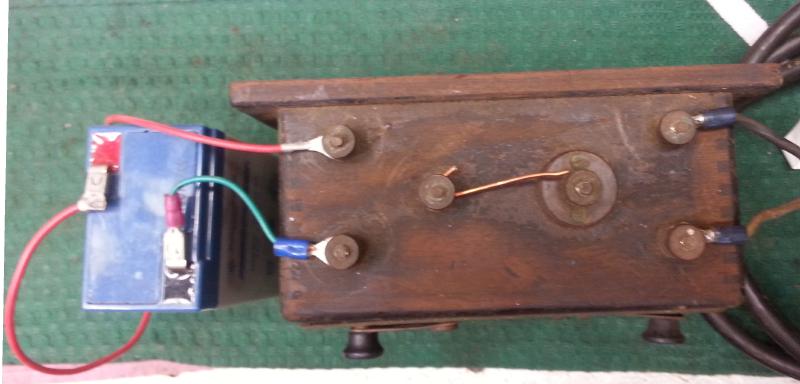
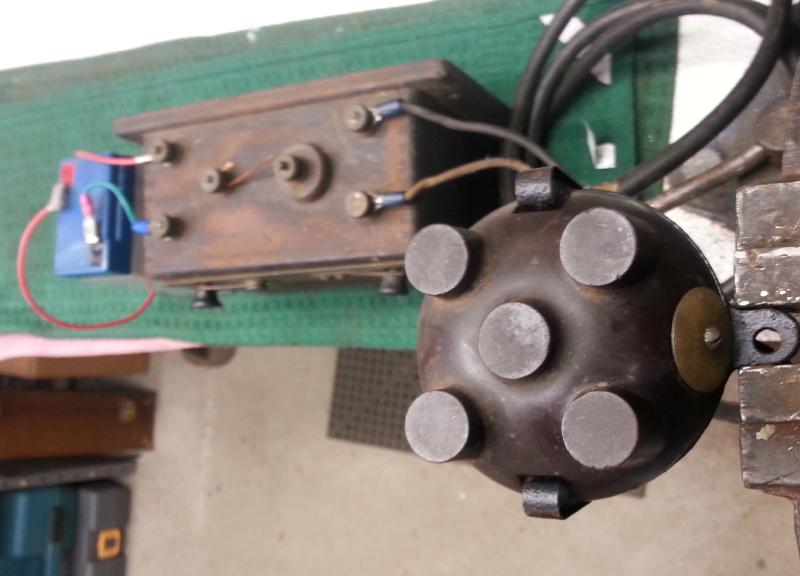
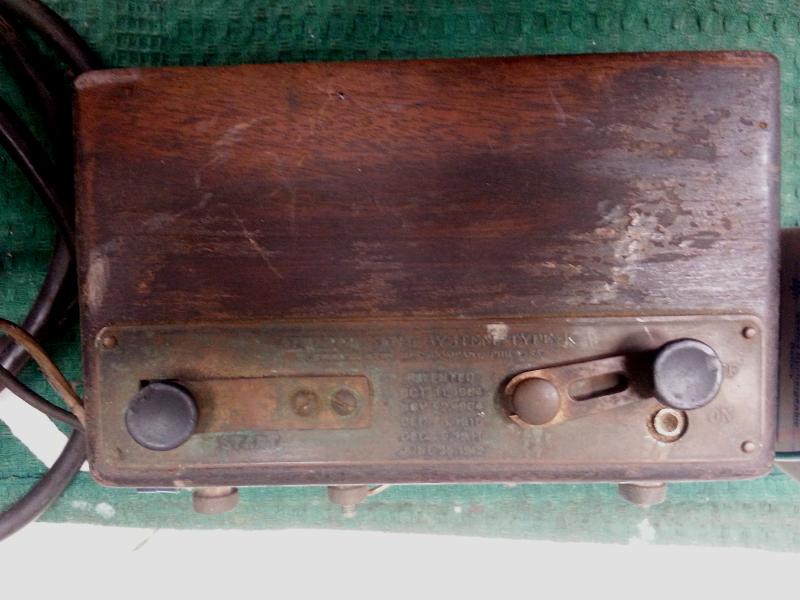
No cylinder distributor cap. Actually just a cover as this is a 1 cylinder timer
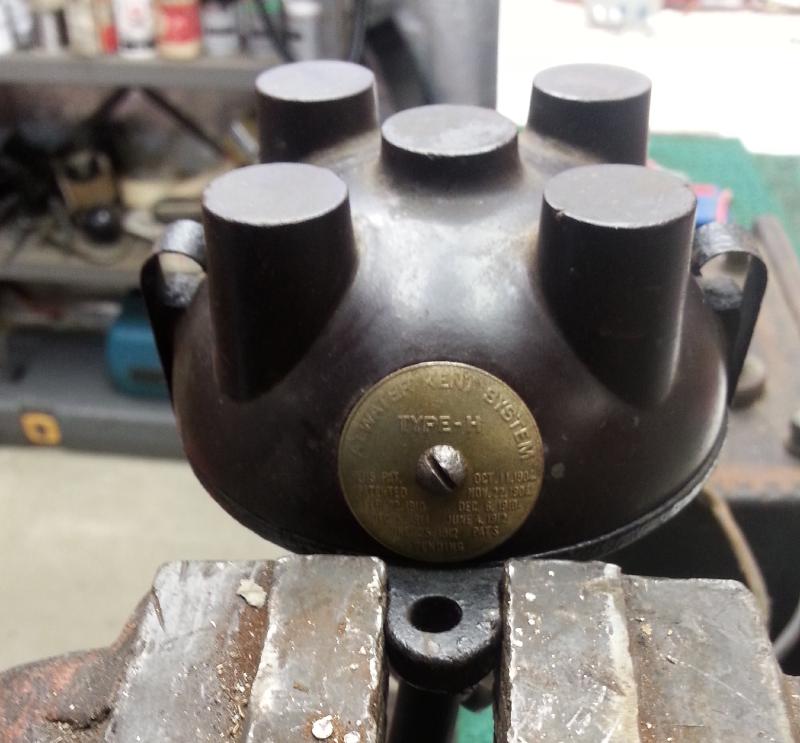
Trip arm between spark/s
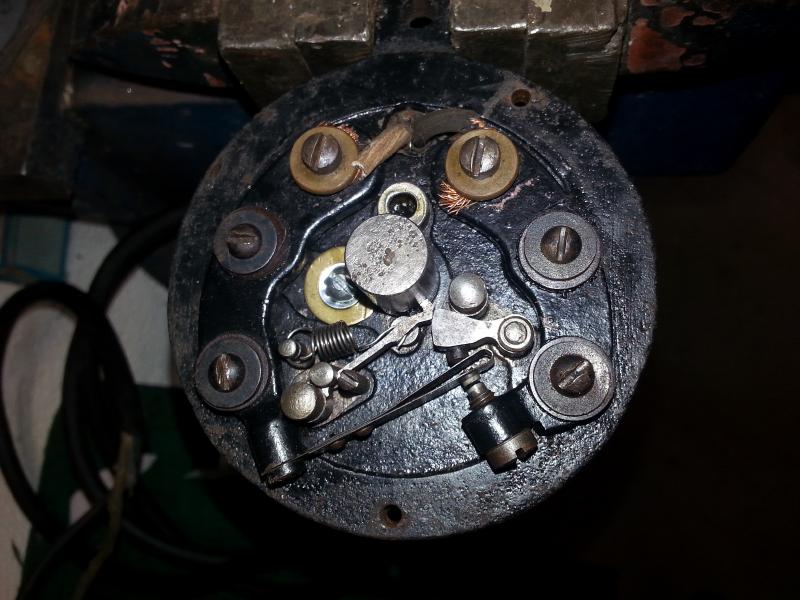
Trip arm ready to trip
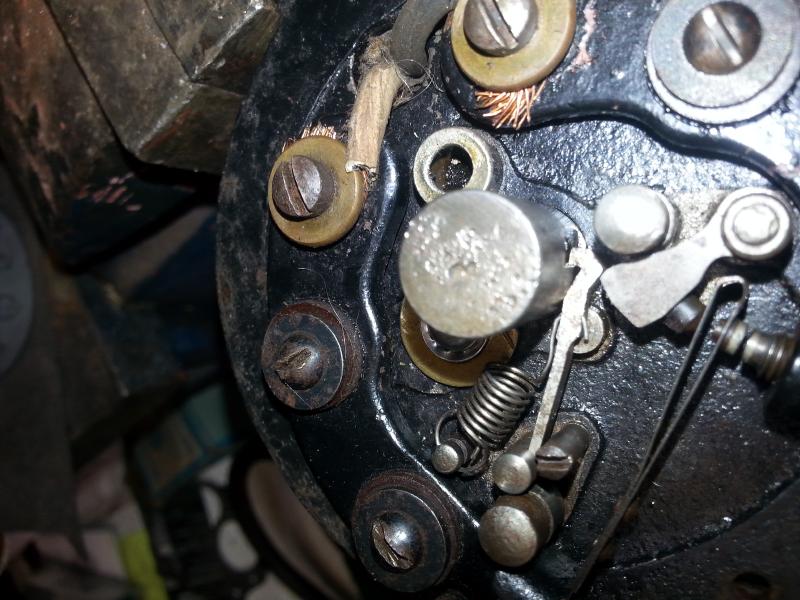 |
    
Ernie
Senior Member
Username: ernie
Post Number: 1871
Registered: 01-2002

| | Posted on Sunday, September 21, 2014 - 12:51 pm: | 




|
More Atwater Kent info
click here |
    
Ernie
Senior Member
Username: ernie
Post Number: 1872
Registered: 01-2002

| | Posted on Sunday, September 21, 2014 - 01:34 pm: | 




|
Hooked up to 6 volts the amp draw is about 385 ma (milli amps) I had to put the meter in the record mode to get a reading. The action of the Atwater Kent is just too quick to see by eye. My digital scope needs a battery so I can't get an actual waveform and dwell time. |
    
Ernie
Senior Member
Username: ernie
Post Number: 1873
Registered: 01-2002

| | Posted on Sunday, September 21, 2014 - 05:54 pm: | 




|
Searching on the net I found an article Dick Day wrote that was published in Gas Engine Magazine back in 1985.
GEM article
click here
His instructions were to have the wires from the distributor to the coil twisted like old lamp cord. I followed his instructions and it works even better.
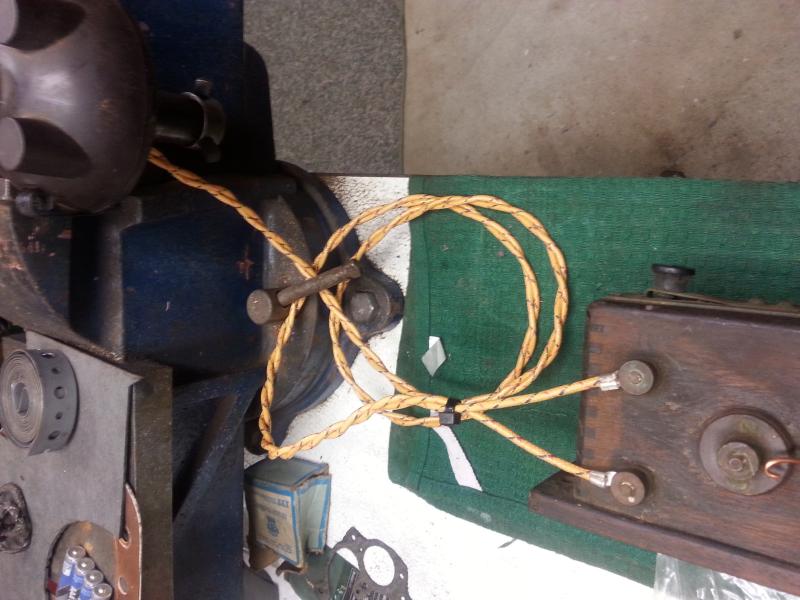 |
    
J.B. Castagnos
Senior Member
Username: jb_castagnos
Post Number: 950
Registered: 07-2002

| | Posted on Sunday, September 21, 2014 - 08:07 pm: | 




|
Ernie, I've seen several of these systems, never had the opportunity to get serious with one. I've wondered if you could use the distributor to operate a relay, the relay points firing a conventional coil. If you think it might work and have a chance to try it, give me a report. There's an old Indiana Tractor at Portland that we would like to run, has the distributor, no coil. |
    
Ernie
Senior Member
Username: ernie
Post Number: 1874
Registered: 01-2002

| | Posted on Tuesday, September 23, 2014 - 07:01 am: | 




|
JB using a Bosch relay I get no action from the relay.
1 maybe not enough current flow as the Bosch relay coil has between 50 and 100 ohms. The AWK coil primary has less than 1 ohm.
2 maybe the AWK timer is just too quick
I am going to try it with a modern coil over plug and see what it does. |
    
Ernie
Senior Member
Username: ernie
Post Number: 1875
Registered: 01-2002

| | Posted on Tuesday, September 23, 2014 - 07:31 am: | 




|
JB it works good hooked directly to a modern coil over plug.
In the pic the coil is from a 2008 Mazda3 2.0L
The connections are plus and minus to the coil. The AWK goes from plus to the coil trigger terminal. The white jumper wire is just a ground from the plug body to minus.
This is a 100KV ignition system so it might not work with an old distributor cap and wires. At the least it will find any and all areas of poor insulation. Maybe just use good solid ignition wire and keep the plug gaps close so the voltage doesn't have a chance to get above 10KV or so.
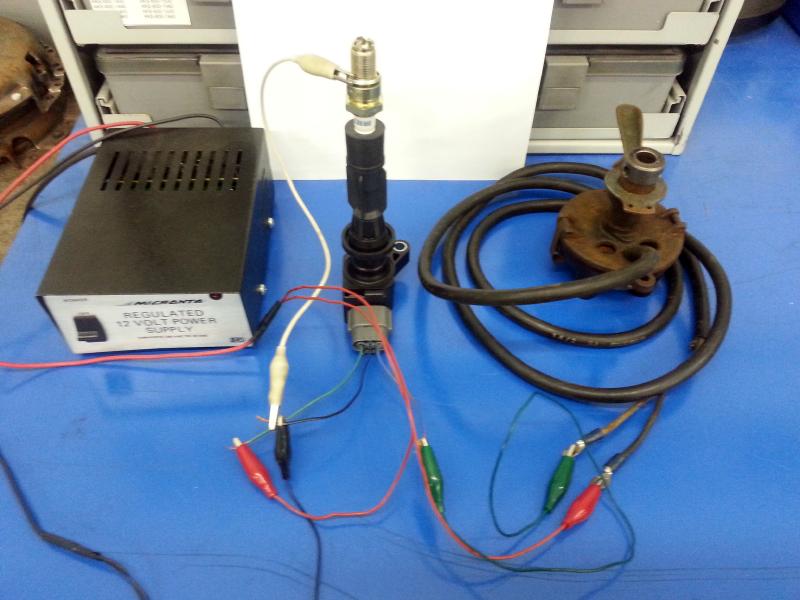 |
    
Ernie
Senior Member
Username: ernie
Post Number: 1877
Registered: 01-2002

| | Posted on Tuesday, September 23, 2014 - 06:25 pm: | 




|
Youtube
Spark gap is almost an inch
click here |
    
J.B. Castagnos
Senior Member
Username: jb_castagnos
Post Number: 951
Registered: 07-2002

| | Posted on Tuesday, September 23, 2014 - 08:43 pm: | 




|
The Mazda coil is a good idea Ernie. In use I would build in a relief gap, maybe .060" or so then to ground in case someone tries to run it with a wire off, spark would have a place to go. |
    
Richard A. Day Jr.
Senior Member
Username: richardday
Post Number: 1107
Registered: 11-2003

| | Posted on Thursday, September 25, 2014 - 05:38 pm: | 




|
Seems to me Ernie has solved the long debated argument that twisting the wires together does give a hotter spark and it probably protects the coil from internal break down. |
    
Ernie
Senior Member
Username: ernie
Post Number: 1878
Registered: 01-2002

| | Posted on Friday, September 26, 2014 - 08:52 am: | 




|
The close time on the AWK points is 2.68 ms measured using a digital scope.
With close time this quick the AWK ignition system had a constant dwell time no matter what the RPM.
On old slow turning engines that were running less than 2,000 RPM giving a distributor speed of less than 1,000 RPM.
This was most likely one of the design factors that made this system work so well.
|
    
miro forest
Senior Member
Username: miro
Post Number: 782
Registered: 11-2001

| | Posted on Thursday, December 11, 2014 - 02:15 pm: | 




|
That You Tube video says it all.
And 6V at about 1/3 A, gives about 2 watts of power.
It makes for long battery life too.
miro |
    
Ernie
Senior Member
Username: ernie
Post Number: 2678
Registered: 01-2002

| | Posted on Wednesday, April 27, 2022 - 05:31 am: | 




|
Here is the AWK timer and a Motorcraft coil on plug on a running engine.
Just to make this clear you can't do this with a Cuno style timer or any timer meant for a buzz coil. Smoke will come out of something other than the exhaust.
The AWK timer has a dwell time of around 3 ms. That is milli seconds. A properly working AWK timer even with the engine off the timer points will not ever be 100% on (closed). These coil over plug coils are designed for a dwell time of 3 to 5 ms (3 ms = 0.003 sec) controlled by the engine computer. And the AWK timer is almost exactly that. In this case 2.68 ms.
On a timer meant for a buzz coil the dwell time is huge. In some cases maybe even in the range of 500 ms (1/2 second). It is also possible for the engine to stop with the timer contacts closed, meaning the coil is on or buzzing until someone remembers to shut the switch off.
More info, pics and a YouTube to follow.
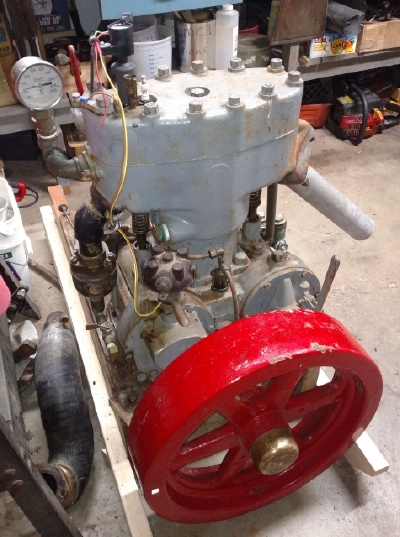
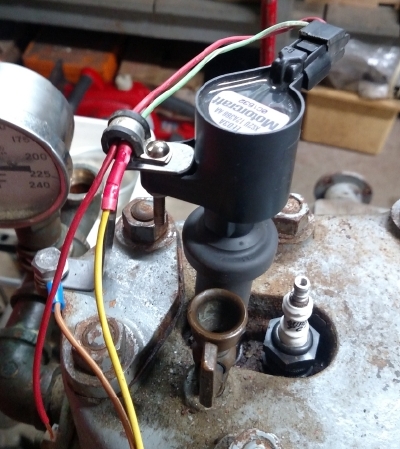
|
    
Ernie
Senior Member
Username: ernie
Post Number: 2679
Registered: 01-2002

| | Posted on Wednesday, April 27, 2022 - 06:04 am: | 




|
You tube of first run using jumper wires etc.
https://www.youtube.com/shorts/FZ4FViBGytQ
AWK ignition systems appeared like they didn't have a condenser, they did and it was in the coil. I had to add a condenser to the timer in this application because the coil over/on plug style coil doesn't have an internal condenser.
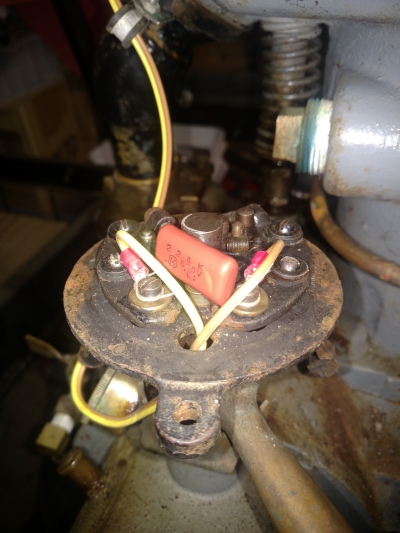 |
    
Ernie
Senior Member
Username: ernie
Post Number: 2680
Registered: 01-2002

| | Posted on Wednesday, April 27, 2022 - 09:40 am: | 




|
Wiring Diagram
The condenser is NP or non polarized. I get them from Digikey
Yes the voltage is 630.
The back inductive kick (voltage spike when the points open) is most likely over 400 volts
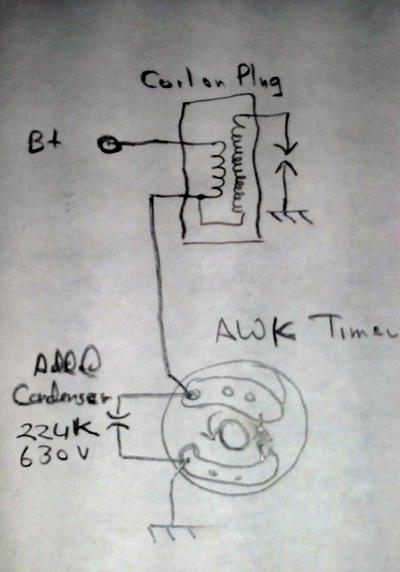 |
    
Ernie
Senior Member
Username: ernie
Post Number: 2681
Registered: 01-2002

| | Posted on Wednesday, April 27, 2022 - 09:45 am: | 




|
More AWK trivia
It has been stated here and other places that you do not file the AWK points as they are tungsten. This engine had been sitting for about 5 years. Previously it was in a boat and being run. I couldn't get any spark when I wired this up. When I looked at the points they were all crusted over with some sort of crusty looking stuff. I just wire wheeled them on my bench grinder. Then they were a dull silver color. I put them back in and now plenty of spark. |
    
Ernie
Senior Member
Username: ernie
Post Number: 2682
Registered: 01-2002

| | Posted on Wednesday, April 27, 2022 - 10:09 am: | 




|
Here is a youtube of it in a boat about 6 years ago.
In this vid it is running with the real AWK ignition system.
This engine is most likely the last 100% Palmer Marine Engine made by a Palmer employee. Henry the gent that assembled it was one of the last Palmer employees and when it was all over he got what was left. As I understand he assembled this engine from parts he had in his shop in the early 70s. There were IH Palmers made into the late 70s.
https://www.youtube.com/shorts/cUkTJ_T2ZnE |
    
Ernie
Senior Member
Username: ernie
Post Number: 2683
Registered: 01-2002

| | Posted on Wednesday, April 27, 2022 - 10:33 am: | 




|
Here it is on YT again as a real vid not a SHORT.
https://www.youtube.com/watch?v=WkmB2m_JExc
So if you are adding vids to YT here is how to keep it from being a SHORT.
A Short is to me one of the most annoying things YT has ever done.
Anyway, do NOT record the video with your phone vertical, or make the video at least 1 second over a minute.
The vid above was done with my phone horizontal. |
    
Dick Briggs
Senior Member
Username: dick_briggs
Post Number: 56
Registered: 02-2015
| | Posted on Saturday, April 30, 2022 - 12:21 pm: | 




|
HI Ernie. Thanks for all this information; I'm not sure I really understand it all, but I'll keep trying. I have a couple of those coil/spark plugs. Can you tell me what type of ignition/timer, other the the AWK, would work with them since a Cuno (and others like them??) won't work? Thanks, Dick |
    
Ernie
Senior Member
Username: ernie
Post Number: 2684
Registered: 01-2002

| | Posted on Saturday, April 30, 2022 - 08:08 pm: | 




|
Dick,
The only timer that will work is an AWK or some solid state replacement that has only a 3 to 5 second ms on time.
Now this being said you say "coil spark plugs" I assume you are not talking about the AWK box. Are they the buzz coil style or just an ignition coil? The Buzz coil style will work with a Cuno style timer. The ignition coil style will work with about any kind of points and condenser. The possible issue is to make sure if the engine quits/stalls that it isn't in a position where the points are closed with the ignition switch on.
Can you post a couple of pics of your coil style plugs?
Hope this helps
Ernie |
    
Dick Briggs
Senior Member
Username: dick_briggs
Post Number: 57
Registered: 02-2015
| | Posted on Sunday, May 01, 2022 - 07:18 pm: | 




|
Thanks again Ernie. You are right, I am not referring to the AWK box. I have two "coil on plug" setups. I think they are what you referred to as buzz coil style; when the top is removed, there is the adjustable vibrator. Pictures:
1.
Connecticut Telephone and Electric Company
Meriden, Conn
Plug Coil
Patented
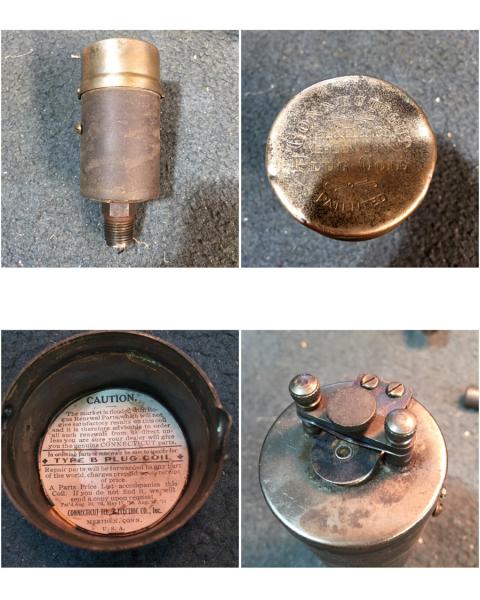
2.
American Coil Co.
Foxboro, Mass
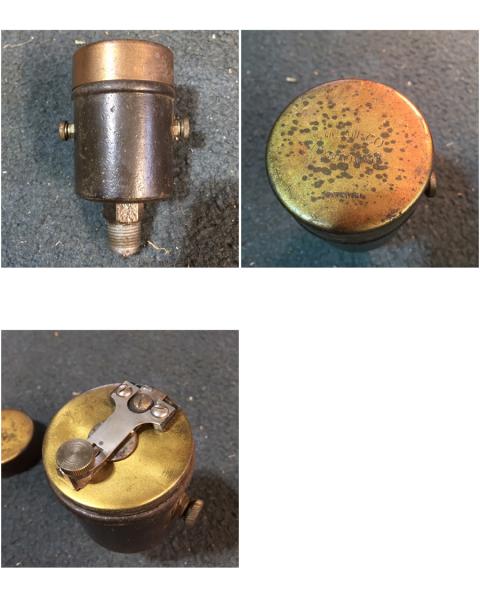 |
    
Ernie
Senior Member
Username: ernie
Post Number: 2686
Registered: 01-2002

| | Posted on Tuesday, June 07, 2022 - 09:00 am: | 




|
Here is the final version of the Palmer ZR1 ignition system.
I wanted to fire both plugs but with the "coil on plug" coils that I have in stock there wasn't enough room for a coil on each plug. The final result is a double tower coil from a 1990 Mazda Miata with a short wire to each plug.
The possibility of me ever putting this engine in a boat is pretty slim. However if that were to happen the old pattern spark plug wire would have to be replaced with plain black rubber insulated wire without the fabric covering because it is very conductive when wet.
The rubber spark plug boots are from an outboard motor. Not that old but they prevent me from laying my hand on a 100KV potential.
There is a large Fahnestock clip below the AWK timer for B- and and a wire that ends below the carb for B+. Other than water and fuel these are the only connections needed to run the engine.
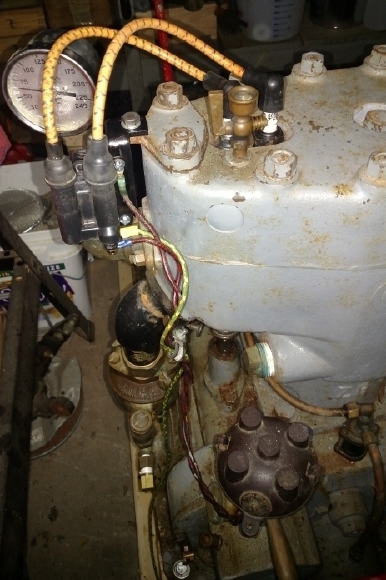
|


